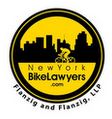'Doored' While Cycling in New York: Not as Simple as Riding a Bike
By Daniel FlanzigContact All Articles
New York Law Journal
May 11, 2012

Daniel Flanzig
May is bike month and with that New York is expected to see an exponential growth in cycling as we enter the cycling season. The New York City Department of Transportation reported that between 2007 and 2009 commuter cycling increased by 45 percent. The city says it remains on track to meet its goal of 1,800 bike-lane miles by 2030, as outlined in the Bike Master Plan and the Bloomberg administration's goal to expand sustainable transportation. With the aggressive promotion of cycling by advocacy groups such as Transportation Alternatives and others, we will see more cyclists on the roads than ever before.
Unfortunately, the transition to safe road-sharing between cars and bikes still has a long way to go. Crashes with motor vehicles still remain the number one concern for New York cyclists. While most assume that the typical bike vs. car crash involves one striking the other, a more common and perhaps even more dangerous crash is what is known in the cycling community as a "dooring," when a vehicle door is opened into a cyclist's path of travel. To an attorney representing the rights of an injured cyclist or to one defending this type of crash, it surprisingly creates a wealth of legal issues, including multiple statutory violations, issues of vicarious liability, conflict of laws, as well as coverage issues that one would not normally contemplate in a simple car on bike crash.
Vehicle and Traffic Law §1214
A "dooring" typically involves an alleged violation of Vehicle & Traffic Law (VTL) §1214. The statute states that: "No person shall open the door of a motor vehicle on the side available to moving traffic unless and until it is reasonably safe to do so, and can be done without interfering with the movement of other traffic, nor shall any person leave the door open on the side of the vehicle available to moving traffic for a period of time longer than necessary to load or unload passengers."
The opening of a car door into traffic in violation of VTL 1214 has been found to be the sole proximate cause of an collision and requires the granting of summary judgment against the person who opens the door into traffic. For example, in Montesinos v. Cote, 46 A.D.3d 774, 848 N.Y.S.2d 329 (2d Dept. 2007), the plaintiff, Lisa Montesinos, opened her door to exit her vehicle when her driver's door made contact with a passing tractor trailer. In her claim against the passing tractor trailer for injuries sustained, the court found that the injured plaintiff's opening of her door into traffic in violation of VTL 1214 was the sole proximate cause of the collision and dismissed her case. See also, Abbas v. Salav, 73 A.D.3d 1100, (2d Dept. 2010), Williams v. Persaud, 19 AD3d 686 (2d Dept. 2005).
In contrast, the courts seem reluctant to grant judgment to a cyclist who is injured when a door is opened into his path. In Villa v. Leandrou, 31 Misc.3d 1237(A), 932 N.Y.S.2d 764 (Sup. Ct. Queens Co. 2011), the court refused to grant plaintiff Alfredo Villa, a cyclist, summary judgment in a "dooring" crash case. Although the court found that the defendant violated VTL 1214 by opening her car door into traffic, it still left open questions of fact as to whether the cyclist's actions caused or contributed to the collision requiring denial of summary judgment to the plaintiff in the issue of liability.
Vicarious Liability
It's clear that the person opening the car door into the path of traffic of a cyclist can be found responsible for the happening of the collision, but they are not alone. Vehicle and Traffic Law 388(1) will also make the vehicle's owner vicariously liable for the acts of its passenger in causing the crash. For example, in Cohn v. Nationwide Mutual Ins. , 286 A.D.2d 699, 730 N.Y.S.2d 152 (2d Dept. 2011), a cyclist brought a claim against a taxicab owner as a result of its passenger opening the cab's door into the path of cyclists, causing injury to the rider. The Second Department found that the passenger's act of opening the taxicab door in order to exit the vehicle "constitutes use and operation of a vehicle pursuant to Vehicle and Traffic Law §388 and, accordingly, an owner of a taxicab will be liable for the Plaintiff's injuries."
The Court of Appeals, in addressing the application of Vehicle and Traffic Law §388 has held that it is not limited to situations where the vehicle is in motion, as the inclusion of loading and unloading of a vehicle fits logically with the interpretation of the law and claims predicated under §388(1) of the Vehicle and Traffic Law. Argentina v. Emery World Wide Delivery , 93 N.Y.2d 554, 693 N.Y.S.2d 493 (1999).
Coverage
Having established who is responsible for the act of "dooring" a cyclist, the next issue then becomes applicable coverage for the occurrence. While the owner may be responsible for the act of its passenger, the Court of Appeals has held that the vehicle's liability policy may not indemnify and defend the negligent passenger for his violation of VTL 1214. In Kohl v. American Transit Insurance, 15 N.Y.3d 763, 906 N.Y.S.2d 809 (2010), passenger Christopher Kohl was exiting a New York City taxicab when he opened the taxicab's door in the path of a cyclist. The cyclist brought a claim against Kohl and others for injuries sustained in the crash. The Court of Appeals, affirming the Appellate Division, held that Kohl was not an insured under the taxi owner's policy of automobile liability insurance. The policy said that it "shall inure to the benefit of any person legally operating" the insured's vehicle in the business of the insured. The word "operating" cannot be stretched to include passengers riding in a car or opening the door. As such, the court refused to require American Transit, the taxi's insurance company, to defend and indemnify the passenger for the act of opening the door into traffic in violation of VTL 1214.
Statutes—Which Apply?
Vehicle and Traffic Law §1214 establishes a clear statutory violation under New York state law, and is helpful to cyclists throughout the state. However, within the confines of New York City, other collision scenarios involving a "dooring" by a cab or private vehicle may find the rider predicating its case under sections of the Traffic Rules and Regulations of the City of New York as well.
Section 1642 of the VTL authorizes the City of New York by local law to supersede the provisions of the VTL, including those that regulate parking. Somersall v. New York Tel., 52 N.Y.2d 157 (1981). However, pursuant to this authority, the City of New York has not superseded VTL 1214 (See N.Y.C. Traffic Rules and Regulations§4–02 [e]; 34 RCNY 4–02[e]) and the statute remains binding on motorists within the city.
There are several examples of applicable New York City codes that can apply to a "dooring" crash. For instance, Section 4-08(e) of theTraffic Rules and Regulations prohibits the stopping, standing or parking of a vehicle within a designated bicycle lane. If a vehicle illegally stops in or adjacent to the bike lane, and the vehicle's door is opened into a cyclist's path, this should create a sufficient code violation to be submitted to a jury. Another example of a potential code violation is §411(c) which requires "taxis while engaged in picking up or discharging passengers must be within 12 inches of the curb or parallel thereto." The rule also prohibits the picking up or discharging of passengers within a bicycle lane. Again, if the door of a cab is opened into a cyclist path, while engaging in the picking up or discharging of passengers in violation of the regulation, this violation of the traffic rules can be charged in addition to VTL 1214.
When representing the cyclist, it is much more advantageous to have the jury charged on a violation of the Vehicle and Traffic Law as a violation of the VTL constitutes negligence as a matter of law and the jury "cannot disregard a violation of the statute and substitute some standard of care other than that set forth in the statute." See, P.J.I. 2:26; see also, Collazo v. Metro. Suburban Bus Auth., 68 AD3d 803, 804 (2d Dept. 2009); Tepoz v. Sosa , 241 A.D.2d 449 (2d Dept. 1997).
By contrast, violation of a municipal ordinance would only constitute "some evidence of negligence." Elliot v. City of New York, 95 N.Y.2d 730, 734 (2001). Where appropriate, the jury would be charged that, if a party violated one or more provisions of the New York City Traffic Rules and Regulations, the jury "may consider the violation as some evidence of negligence, along with the other evidence in the case, provided that such violation was a substantial factor in bringing about the occurrence." (See Pattern Jury Instruction 2:29; see also Ferrer v. Harris, 55 N.Y.2d 285, 293 (1982); Schneider v. Diallo, 14 AD3d 445, 446 (1st Dept. 2005)).
Neither the Vehicle and Traffic Law or Regulation are mutually exclusive and the jury can be charged on both the VTL as well as a municipal ordinance as long as the two statutes are not essentially consistent with each other. Collazo, supra., Fox v. Lyte, 143 A.D.2d 390, 532 N.Y.S.2d 432 (2d Dept. 1988).
However, whether a provision of the Vehicle and Traffic Law or a provision of the New York City Traffic Rules and Regulations is at issue, the jury should not be charged as to an alleged violation "if the statute [or local rule] is intended to protect against a particular hazard, and a hazard of a different kind is the occasion of the injury." Narducci v. Manhasset Bay Assocs., 96 N.Y.2d 259, 267 (2001), DiPonzio v. Reardon, 89 N.Y.2d 578, 584–85 (1997). It will be incumbent upon the attorney representing the cyclist to present to the trier of fact sufficient proof that the alleged statutory violation is applicable to the facts of the crash and that it was the intent of the statute to protect the cyclist, among others, from harm.
Conclusion
A "dooring" crash, which seems simple at first glance, creates a wealth of legal issues not normally contemplated in a bike vs. car collision. When representing a cyclist, a practitioner needs to be familiar with both the state and local laws of its jurisdiction, and be able to present a compelling case to take advantage of the applicable laws that are in effect to protect cyclists in New York.
Daniel Flanzigis a partner at Flanzig and Flanzig. He can be reached at DFlanzig@NewYorkBikeLawyers.com.


